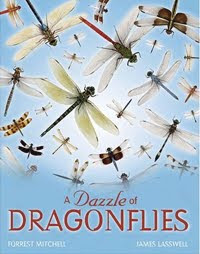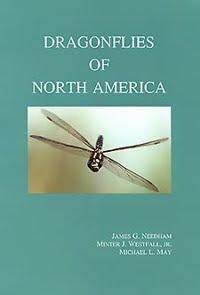 I have spent $234 on dragonfly books the last couple of months. My first round of purchases included Wild Guide: Dragonflies, The Beginner's Guide to Dragonflies, and A Dazzle of Dragonflies. The Wild Guide book [$20] includes drawings, not photographs; it is a simple thing—a kid in middle school could understand it—but well written and interesting. At the beginning of spring, I didn't know much about dragonfly life cycles or behavior, and this book has helped me understand what I am observing down at the water.
I have spent $234 on dragonfly books the last couple of months. My first round of purchases included Wild Guide: Dragonflies, The Beginner's Guide to Dragonflies, and A Dazzle of Dragonflies. The Wild Guide book [$20] includes drawings, not photographs; it is a simple thing—a kid in middle school could understand it—but well written and interesting. At the beginning of spring, I didn't know much about dragonfly life cycles or behavior, and this book has helped me understand what I am observing down at the water. The tiny A Beginner's Guide [$9] is full of color photos and descriptions. Maps make it hard to misidentify a species because I can say, "Whoa, Florida isn't colored green on the map. This specimen must be something else." It is another simple book, but as I am trying to get a handle on what I'm seeing, it too has been helpful.
The tiny A Beginner's Guide [$9] is full of color photos and descriptions. Maps make it hard to misidentify a species because I can say, "Whoa, Florida isn't colored green on the map. This specimen must be something else." It is another simple book, but as I am trying to get a handle on what I'm seeing, it too has been helpful. A Dazzle of Dragonflies [$40] includes not only photos but also scans. The authors took laptop computers and flatbed scanners into the swamps, netted dragonflies, cooled them on ice, posed them on the glass, and scanned them. This book is helpful with identification, although the accompanying website, Digital Dragonflies, has a better selection of species. What I like best about Dazzle is the chapter on dragonfly mythology. The dragonfly, for example, is a servant of the devil for Europeans but an advanced spiritual being for Native Americans. The writing in this work isn't the best, but I am happy to add it to my collection.
A Dazzle of Dragonflies [$40] includes not only photos but also scans. The authors took laptop computers and flatbed scanners into the swamps, netted dragonflies, cooled them on ice, posed them on the glass, and scanned them. This book is helpful with identification, although the accompanying website, Digital Dragonflies, has a better selection of species. What I like best about Dazzle is the chapter on dragonfly mythology. The dragonfly, for example, is a servant of the devil for Europeans but an advanced spiritual being for Native Americans. The writing in this work isn't the best, but I am happy to add it to my collection.None of the first three books I purchased included any information about four-spotted pennants, however. This species of dragonfly frustrates me because I see so many color variations when I am at Lake Pamela. Unlike blue dashers or Eastern pondhawks, which both have distinctive gender colors, the four-spotted pennants do not; moreover, they seem to color morph as they mature more dramatically than any other dragonfly I have seen in the area. So I bought Dragonflies through Binoculars and Dragonflies of North America, hoping for some help with this particular species.
 Dragonflies through Binoculars [$30] is an expanded A Beginner's Guide—more species, longer descriptions. Concerning four-spotted pennants, it says that this species is the only North American dragonfly "with entirely white stigmas [small marking at the front of the front wings]" and that "females darken more slowly than males, retain white facial spots." The note about white stigmas helps me confirm that I am observing four-spotted pennants—not misidentifying some other species—but the "slow darkening" contradicts the scan of a female at Digital Dragonflies, which shows coloring different from that of males. So I can't tell if this specimen below, for example, is a female [does have the white facial spots] or a male [typical male coloring]:
Dragonflies through Binoculars [$30] is an expanded A Beginner's Guide—more species, longer descriptions. Concerning four-spotted pennants, it says that this species is the only North American dragonfly "with entirely white stigmas [small marking at the front of the front wings]" and that "females darken more slowly than males, retain white facial spots." The note about white stigmas helps me confirm that I am observing four-spotted pennants—not misidentifying some other species—but the "slow darkening" contradicts the scan of a female at Digital Dragonflies, which shows coloring different from that of males. So I can't tell if this specimen below, for example, is a female [does have the white facial spots] or a male [typical male coloring]: ![Male four-spotted pennant [Brachymesia gravida]](https://blogger.googleusercontent.com/img/b/R29vZ2xl/AVvXsEj5atIRRE1mYsoEEww3P747c2xwV1OpNlAx97nCEIXpqwl5vV9MQ7TJU0xX8633tJkbyqqTN-IYOfOCe1p2TGsvPULd-qsgkVWWGBEwodPfI97TQfpVcQ1SqqQoOYzWgt_5cFNgHAMboYS9/s400/05_31_2006_02.jpg)
 Dragonflies of North America [$125] is advanced scholarship, years in the making. This thick, heavy hardback is a biologist's book, not targeted for the lay person. It is as dense as it is beautiful. The authors call the four-spotted pennant "a very handsome species," an opinion about looks not typical of most of the descriptions of other dragonflies, an opinion that indicates the authors' own appreciation for the species. This work claims that the face of a four-spotted pennant is "black and white," apparently for both males and females, contradicting the information in Dragonflies through Binoculars.
Dragonflies of North America [$125] is advanced scholarship, years in the making. This thick, heavy hardback is a biologist's book, not targeted for the lay person. It is as dense as it is beautiful. The authors call the four-spotted pennant "a very handsome species," an opinion about looks not typical of most of the descriptions of other dragonflies, an opinion that indicates the authors' own appreciation for the species. This work claims that the face of a four-spotted pennant is "black and white," apparently for both males and females, contradicting the information in Dragonflies through Binoculars.I have learned a little about dragonfly genitalia, so I know to look for a male's "package." Often, though, I don't get the "package" in the shot, so I can't confirm gender that way.
I could probably find a bio professor who would go out and net some specimens with me and then tutor me on dragonfly gender, but I would feel that I was mixing too much science with the art. Plus, gender identification might include dissection, and although I have no strong complaints about the process, I personally don't want to cut up one of the little guys myself. So I'm just going to share some new pictures, gender be damned:
![Four-spotted pennant [Brachymesia gravida]](https://blogger.googleusercontent.com/img/b/R29vZ2xl/AVvXsEi69CiesWZa2GArfPYiA1FXeK95S6ES-_Qv0d1TBbPY5Dl9ZU7OYWZfHHeLzq2gBoM7VoUF1cxW7mn5ZCJT54FvDXQw_prNbolWS9HBckKKJAF8MHRHiQP3IKzu9Nj8purm1RXKtkbFgDHb/s400/06_28_2006_10.jpg)
![Four-spotted pennant [Brachymesia gravida]](https://blogger.googleusercontent.com/img/b/R29vZ2xl/AVvXsEhS3TJuhkuFz4Bssel8wP4s_cVC7NyjbpP4_oeGhOWTqjdakQ1t-l8t4irDL43g1KuPnOxF_ySjsJm1jZtP3xNp4drl4MiP42umJru6zT0pfWaClnopjZbumzUtoahYAnMVB-xlj-OFfCL1/s400/06_28_2006_09.jpg)
![Four-spotted pennant [Brachymesia gravida]](https://blogger.googleusercontent.com/img/b/R29vZ2xl/AVvXsEiA3hqfoZLwfFWTXGNXhva2y_ICzxMMsdjxOhXMvQInp0m5kBZ1i7jI8aSsqIGfRjkXGFHLdt-GeZRIMM_HWNB7uYQ7w-qXeimd-mkMsGRK94J0H6C1vY99M9fu8bKeDWiFu2dJwgThXBCT/s400/06_28_2006_08.jpg)
![Four-spotted pennant [Brachymesia gravida]](https://blogger.googleusercontent.com/img/b/R29vZ2xl/AVvXsEjzMh7eBo8MFQdhvslyLB5SvACSBxx9rG48RlGmUoIb1QiuwrzKLiPLUwIKpL3KQ7tsVvzs7TjSu2xhqfbhHsQeYdIU8NdmpBDqnZXHWx3l4EoEbAF9Z4zK1A4TMEiw9Zgl_IL6i_U6TLWa/s400/06_28_2006_07.jpg)
![Four-spotted pennant [Brachymesia gravida]](https://blogger.googleusercontent.com/img/b/R29vZ2xl/AVvXsEiIVtZ216LUJVfznTv9l7xlyeFaZum4fwQ9Kq3xCn8208M_Gegnb9n7zyR42eEtofscf-Bw0DGEz5LYlAIwhnhY8HWYIbLYcZDqOfCh9YFtk_IhU91dto1xE8t9FWd0V8l5e44pw_uAQ1EP/s400/06_28_2006_06.jpg)
I can't explain my fondness for this species. Maybe it's that I alone know that Lake Pamela is overrun with them, so they are my personal little world that no one else on the planet appreciates. The mature males perch on plants in the water, battling each other over the lake. The others—females or immatures, I give up—hang from the dead branches at the shore, as though they are Coliseum spectators watching gladiator battles below. They are not the easiest dragonfly species to shoot—blue dashers, for example, will let me get so close that I can't focus the 300 mm lens and have to back up--but these pennants do tolerate my presence well enough. They're not flashy colored but wonderful nonetheless in their Darth Vader beauty.


